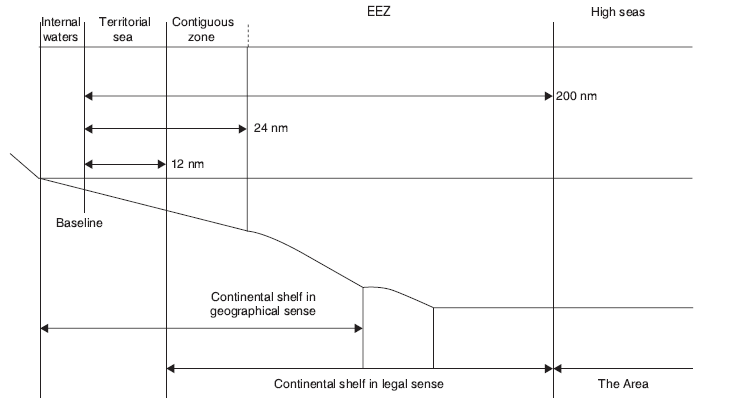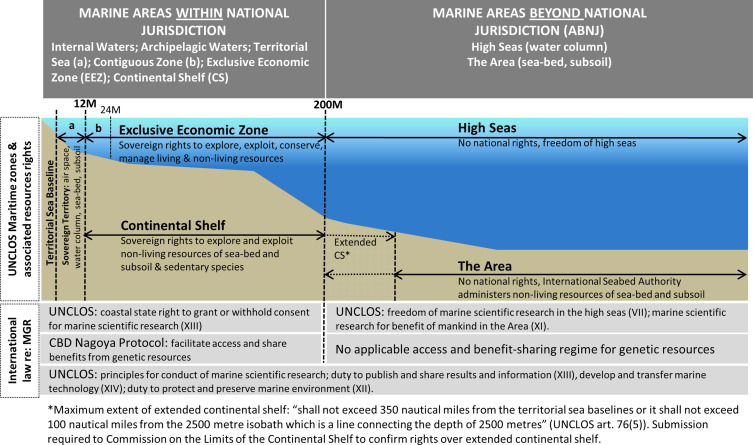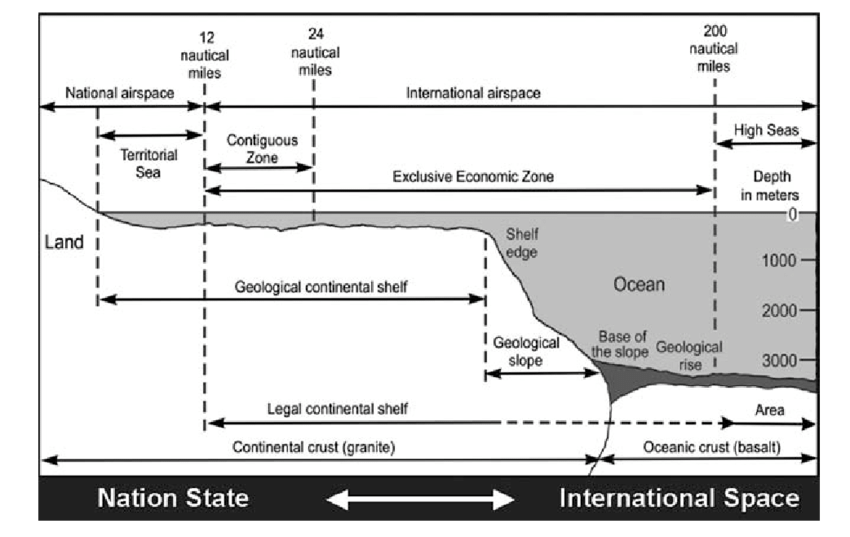A spatial typology for the sea, beyond national jurisdiction, contiguous zone, High seas, internal waters, international straits, jurisdictional zones, Marine Zones, national jurisdiction, what is territorial seas, Typology of Marine Spaces, What is a maritime space?
marine spaces are divided into several jurisdictional zones in the contemporary international law of the sea. On the basis of the national jurisdiction of the coastal State, these marine spaces can be divided into two main categories: marine spaces under national jurisdiction and spaces beyond national jurisdiction. The former category contains internal waters, territorial seas, international straits, archipelagic waters, the contiguous zone, the EEZ and the continental shelf, while the latter contains the high seas and the Area. Further to this, the present writer proposes to divide the marine spaces under national jurisdiction into two sub-categories.



The first sub-category concerns marine spaces governed by territorial sovereignty. This category of marine spaces contains internal waters, territorial seas, international straits and archipelagic waters. Territorial sovereignty is characterised by completeness and exclusiveness. It denotes complete jurisdiction in the sense that it comprises three elements unless international law provides otherwise:
(i) Territorial sovereignty comprises comprehensive jurisdiction, which includes both legislative and enforcement jurisdiction, over the State’s territory.
(ii) The State exercises its jurisdiction over all matters within its territory. In other words, territorial sovereignty contains no limit ratione materiae.
(iii) The State exercises its jurisdiction over all people regardless of their nationalities. Territorial sovereignty thus contains no limit ratione personae.
At the same time, territorial sovereignty is exclusive in the sense that only the State in question may exercise jurisdiction over its territory. In summary, in its territory, the State exercises legislative and enforcement jurisdiction over all matters and all people in an exclusive manner unless international law provides otherwise.
It is important to note that territorial sovereignty is exercisable solely within the territory in question. In this sense, territorial sovereignty is spatial by nature. A jurisdiction that relates to a certain space and can be exercised solely within the space in question may be called ‘spatial jurisdiction’. Territorial sovereignty is a typical example of spatial jurisdiction.
In light of the comprehensive character of territorial sovereignty, one may call territorial sovereignty the complete spatial jurisdiction. In short, internal waters, territorial seas, international straits and archipelagic waters are marine spaces under territorial sovereignty or complete spatial jurisdiction.
The second sub-category relates to marine spaces beyond territorial sovereignty but under the national jurisdiction of the coastal State. It is clear that the EEZ and the continental shelf are included in this category. Considering that the contiguous zone becomes part of the EEZ where it is established, it may not be unreasonable to put the contiguous zone into the same sub-category as the EEZ.
The coastal State jurisdiction over the EEZ as well as the continental shelf – called sovereign rights – is limited to the matters defined by international law (limitation ratione materiae). In this regard, sovereign rights must be distinguished from territorial sovereignty per se, which is comprehensive unless international law provides otherwise. Apart from this, however, sovereign rights have commonalities with territorial sovereignty:
(i) Sovereign rights concern a certain space and can be exercised solely within the space in question, that is to say, the EEZ as well as the continental shelf. In this sense, such rights are spatial by nature.
(ii) Concerning matters defined by law, the coastal State may exercise legislative and enforcement jurisdiction in the EEZ as well as the continental shelf.
(iii) The coastal State exercises its jurisdiction over all people regardless of their nationalities within the certain space in question. Thus, sovereign rights contain no limit ratione personae. In this respect, jurisdiction over the EEZ as well as the
continental shelf should be distinguished from personal jurisdiction.
(iv) Sovereign rights are exclusive in the sense that no one may undertake the exploration and the exploitation of natural resources without the express consent of the coastal State.
The essential point is that, in common with territorial sovereignty, sovereign rights over the EEZ and the continental shelf are spatially limited by nature. The fact that jurisdiction can be exercised solely within the certain space is the essential element of spatial jurisdiction. The coastal State jurisdiction over the EEZ and the continental shelf is also essentially
characterised by the spatial element. Hence, it may be argued that sovereign rights over the EEZ and the continental shelf can be regarded as a sort of spatial jurisdiction, not as personal or any other type of jurisdiction, although it must be distinguished from territorial sovereignty. Considering that, unlike territorial sovereignty, sovereign rights are limited in their material scope, however, these rights should be called limited spatial jurisdiction.
In summary, spatial jurisdiction comprises both complete spatial jurisdiction (= territorial sovereignty) and limited spatial jurisdiction (= sovereign rights). In either case, it must be stressed that coastal State jurisdiction over marine spaces is spatial by nature. It follows from the above discussion that marine spaces in the law of the sea can be categorised as follows :
(i) Marine spaces under national jurisdiction
(a) Marine spaces under territorial sovereignty (or complete spatial jurisdiction): internal waters, the territorial sea, international straits, and archipelagic waters.
(b) Marine spaces under sovereign rights (or limited spatial jurisdiction): the contiguous zone (where the EEZ is established), the EEZ and the continental shelf.
(ii) Marine spaces beyond national jurisdiction the high seas and the Area.
source: The International Law of the Sea, Yoshifumi Tanaka

